Abstract
Glyceraldehyde 3-phosphate dehydrogenases (EC 1.2.1.12 and 1.2.1.13) have been purified from the seed, root, etiolated, and green shoot of peas (Pisum sativum). These enzymes are tetramers of 140,000 daltons, with subunits of 35,000 daltons. The enzymes differ in isoelectric point. The seed enzyme has a pI of 5.1, and the root enzyme has a pI of 4.5. The cytoplasmic enzyme from etiolated shoots is slightly acidic with a pI of 5.7 to 6.1 and is found in two separable forms. The chloroplast enzyme (from green shoots) is most basic with a pI of 8.0.
In immunodiffusion experiments, the seed, root, and cytoplasmic enzymes of the etiolated shoot share antigenic homology, while the chloroplast enzyme does not cross react antigenically with the extra-chloroplast enzymes. The antiserum to the pea chloroplast enzyme did, however, cross react with glyceraldehyde 3-phosphate dehydrogenase purified from the spinach chloroplast. Therefore, the chloroplast enzyme is significantly different from the extra-chloroplast enzymes with respect to primary sequence.
The NADP analog phosphoadenosine diphosphoribose showed competitive inhibition to the chloroplast enzyme with either pyridine nucleotide. The NAD analog pyridine 3-aldehyde NAD was competitive with respect to the NAD activity but was hyperbolic competitive in the presence of NADP, indicating a complexity in the binding of pyridine nucleotide to the chloroplast enzyme.
Full text
PDF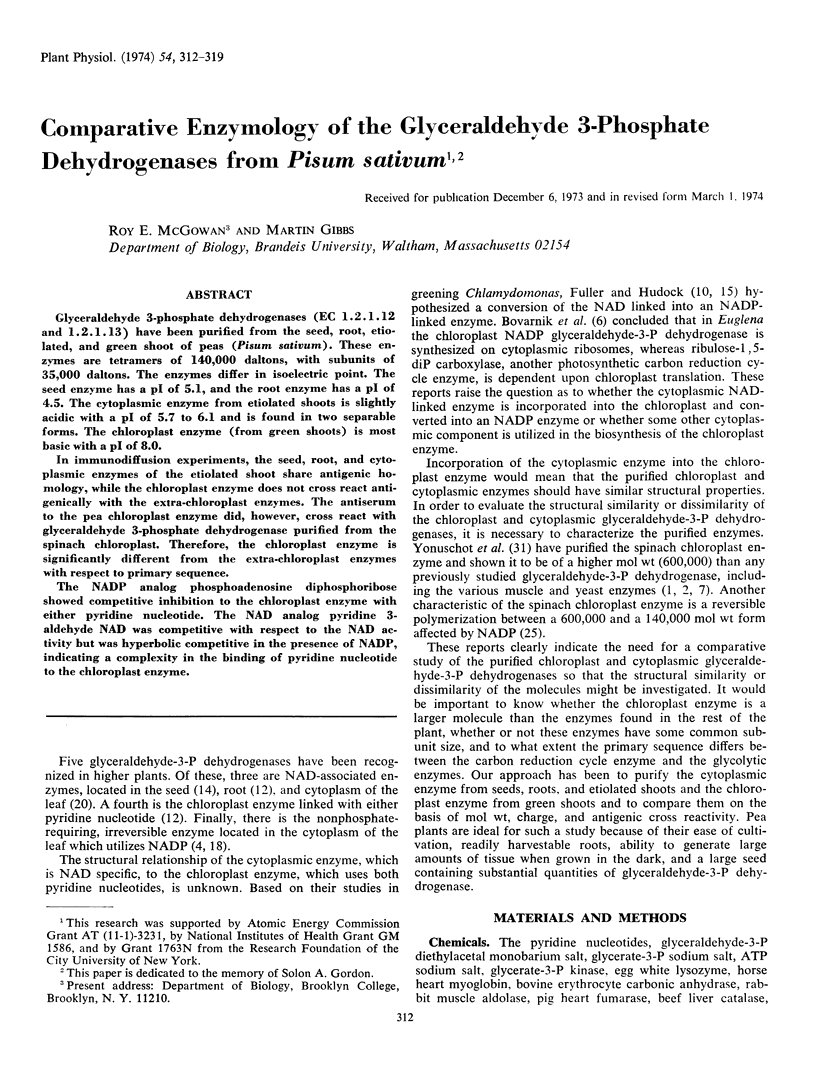
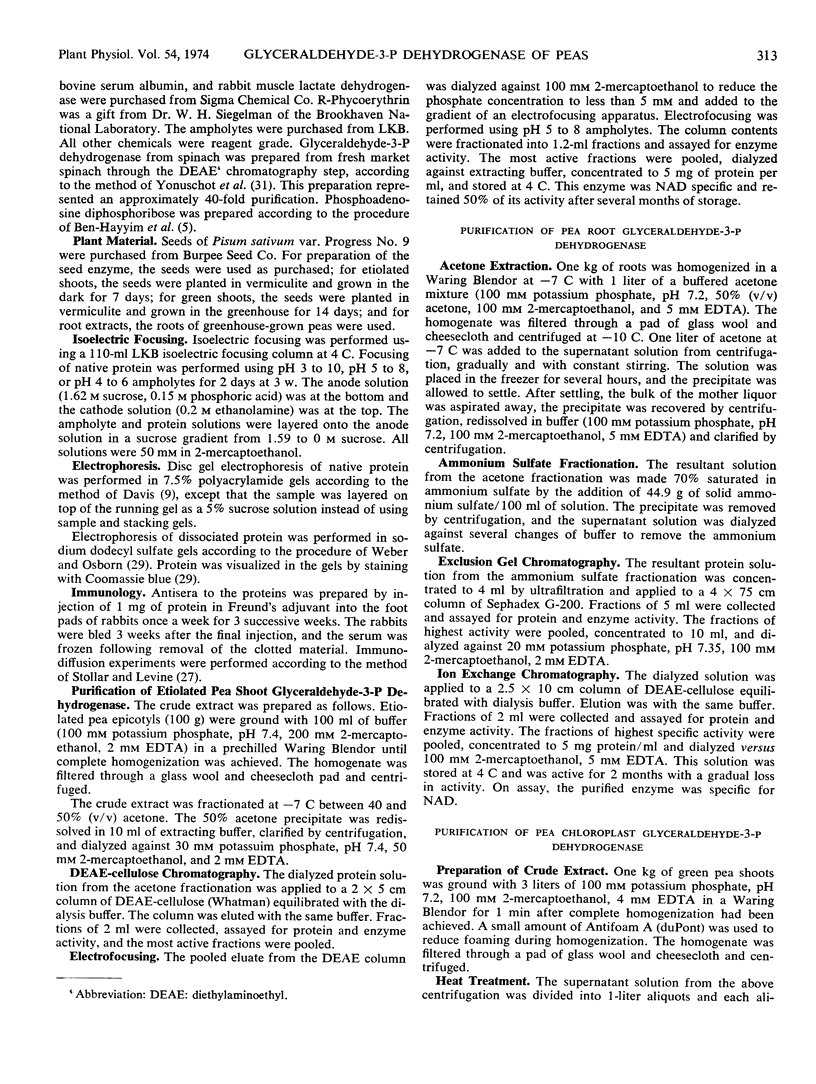
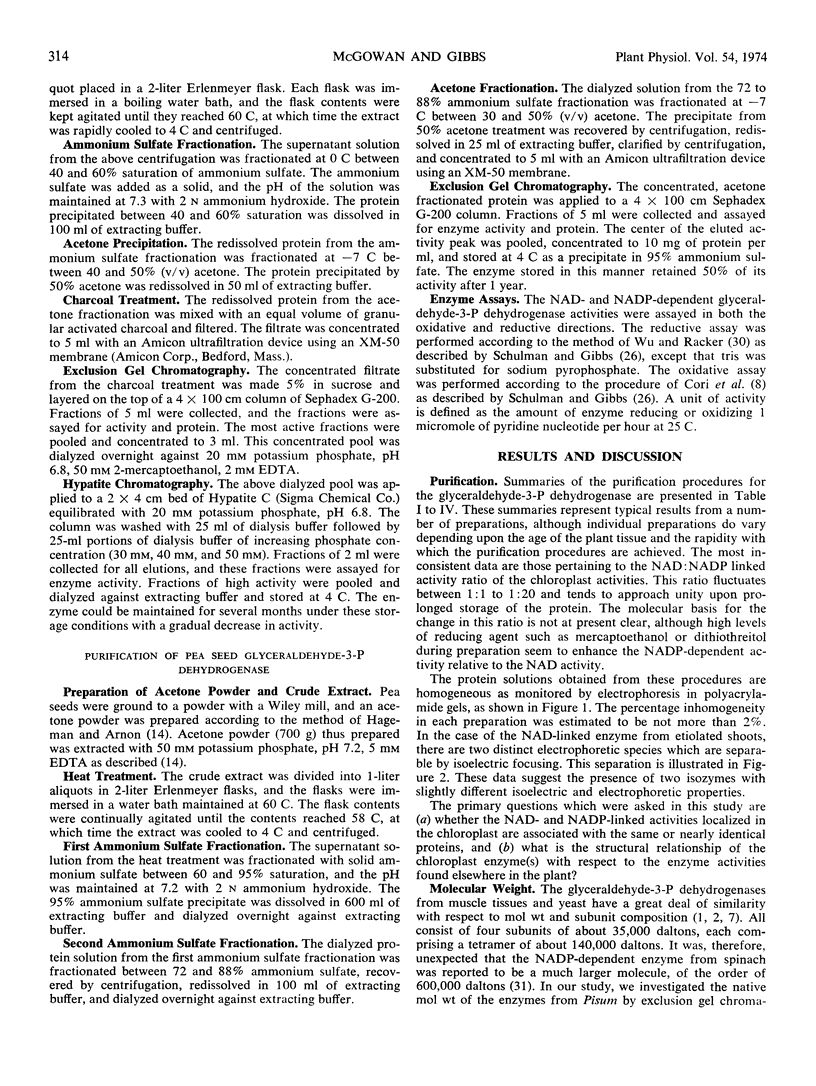
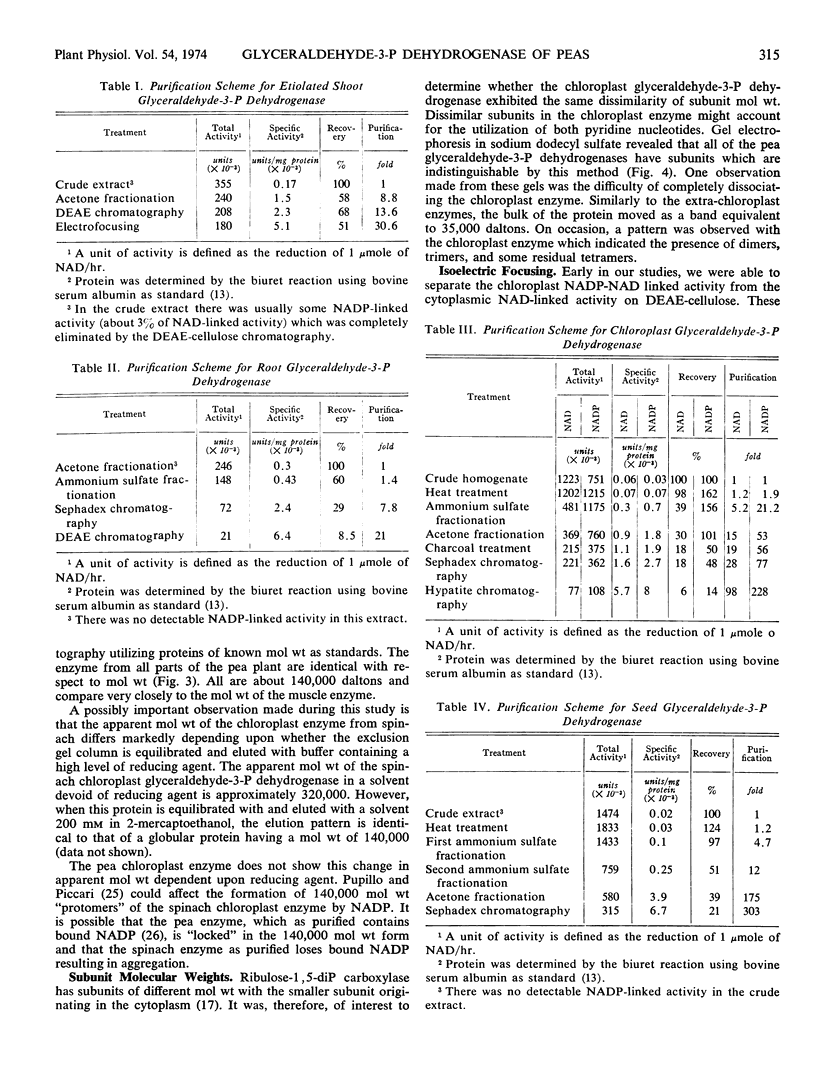
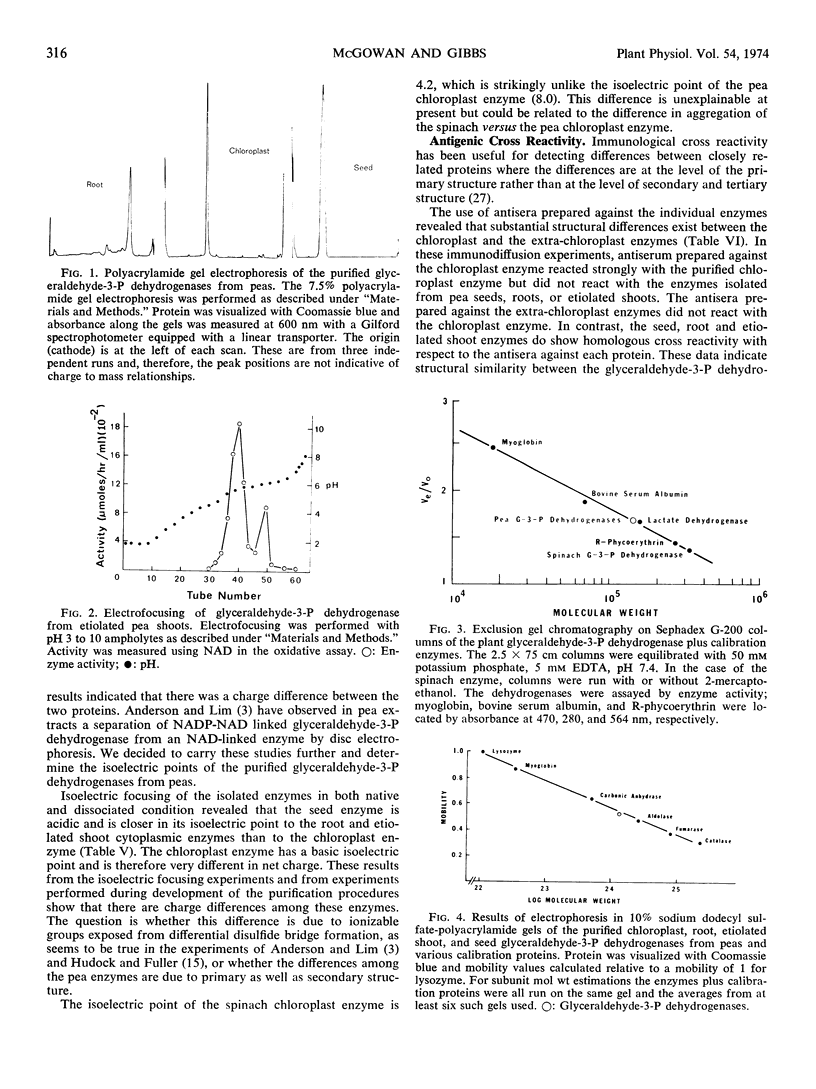
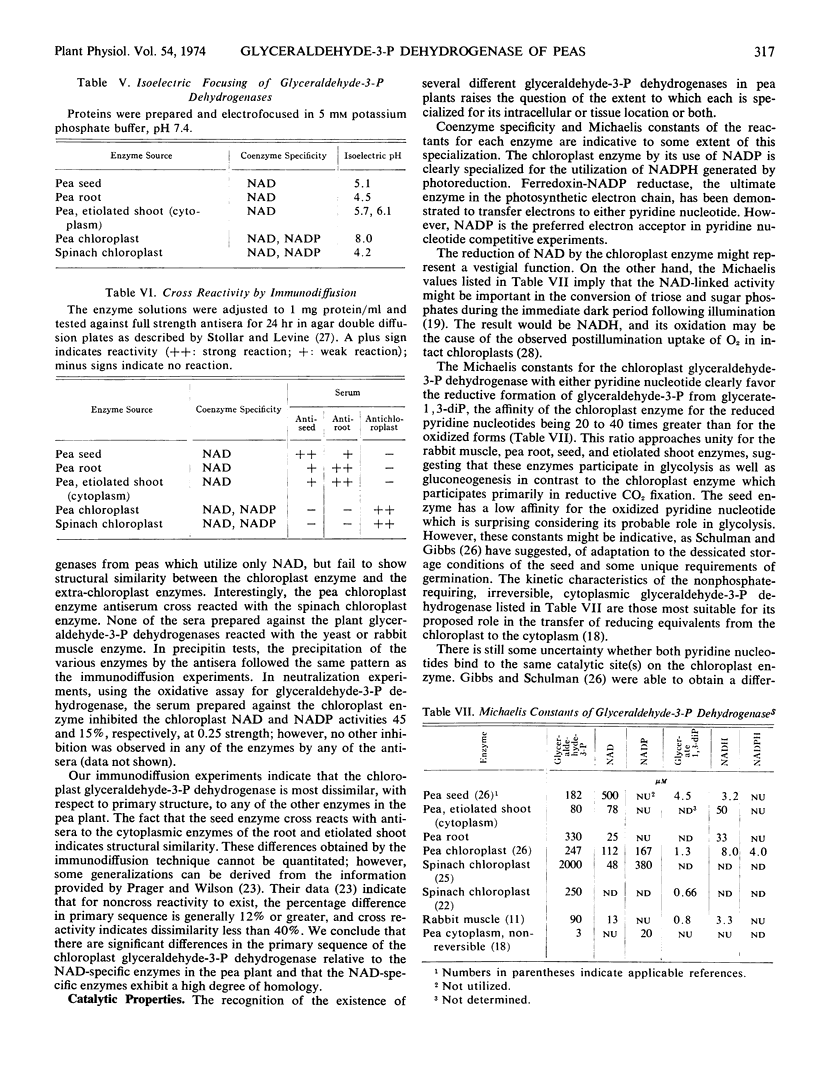
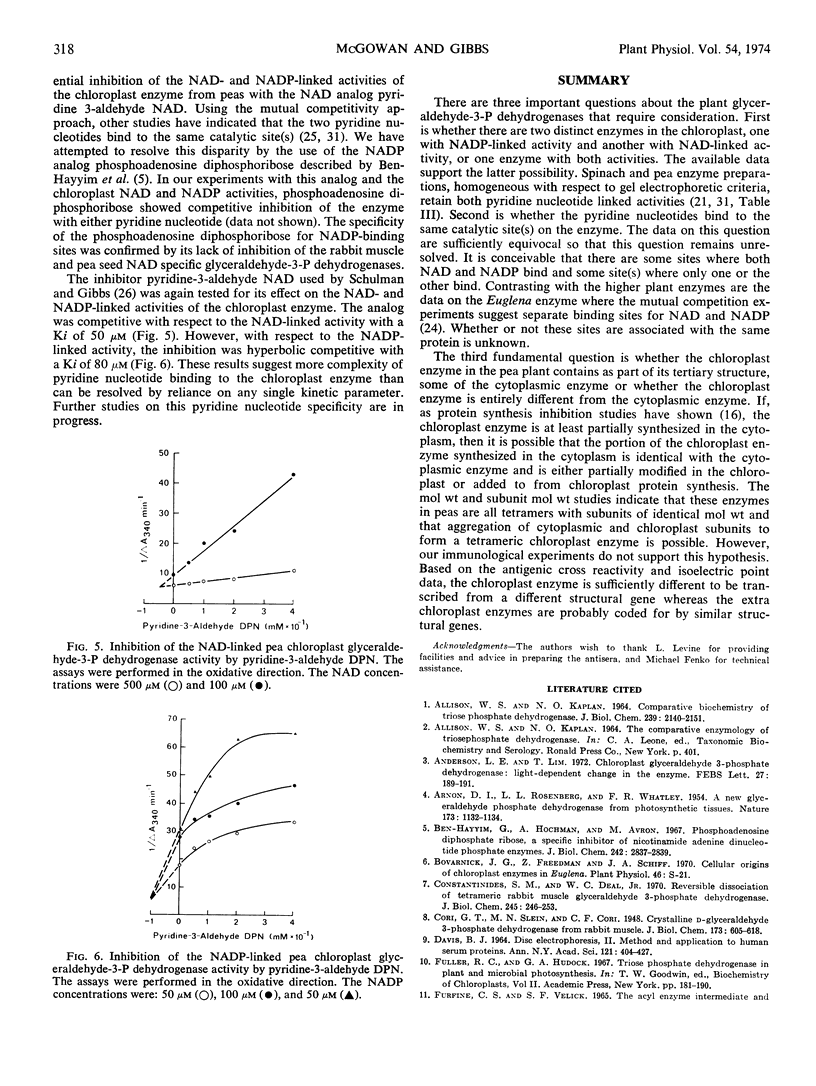
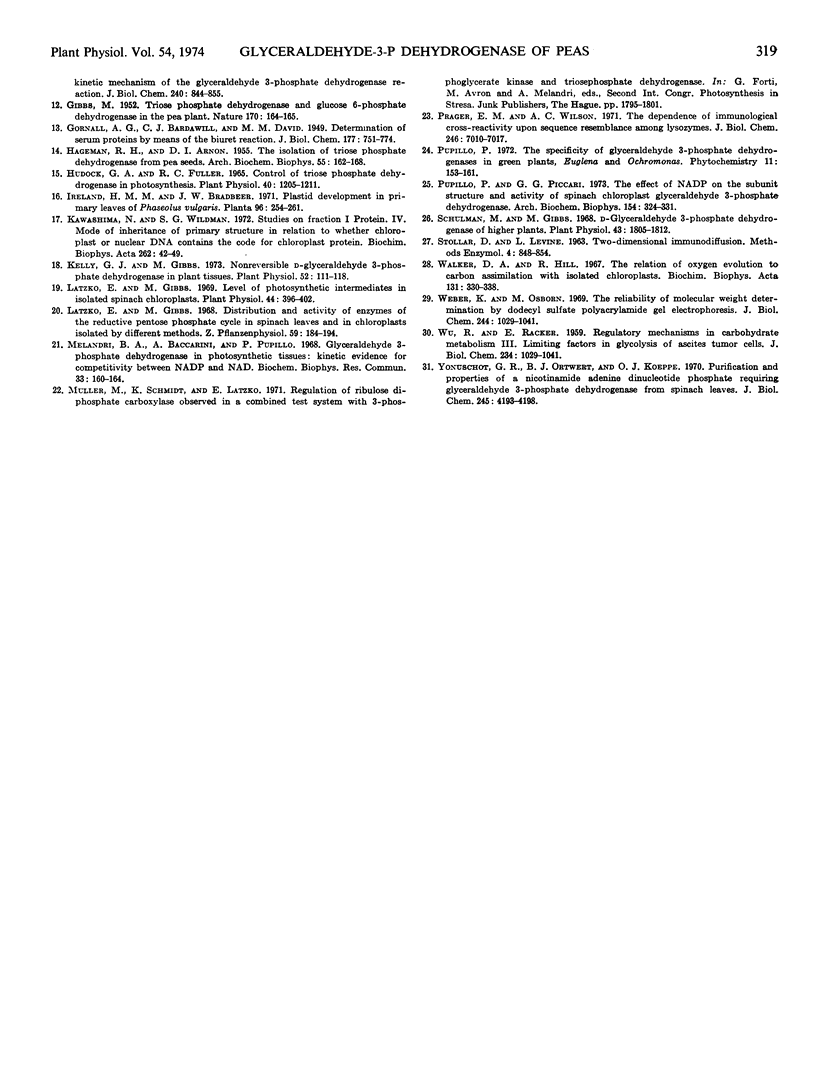
Selected References
These references are in PubMed. This may not be the complete list of references from this article.
- ALLISON W. S., KAPLAN N. O. THE COMPARATIVE ENZYMOLOGY OF TRIOSEPHOSPHATE DEHYDROGENASE. J Biol Chem. 1964 Jul;239:2140–2152. [PubMed] [Google Scholar]
- Anderson L. E., Lim T. C. Chloroplast glyceraldehyde 3-phosphate dehydrogenase: light-dependent change in the enzyme. FEBS Lett. 1972 Nov 1;27(2):189–191. doi: 10.1016/0014-5793(72)80616-1. [DOI] [PubMed] [Google Scholar]
- Ben-Hayyim G., Hochman A., Avron M. Phosphoadenosine diphosphate ribose, a specific inhibitor of nicotinamide adenine dinucleotide phosphate enzymes. J Biol Chem. 1967 Jun 25;242(12):2837–2839. [PubMed] [Google Scholar]
- Constantinides S. M., Deal W. C., Jr Reversible dissociation of tetrameric 7.4 S rabbit muscle glyceraldehyde 3-phosphate dehydrogenase into 4.4 S dimers by' ammonium sulfate and into 3.2 S monomers by KC1. J Biol Chem. 1970 Jan 25;245(2):246–253. [PubMed] [Google Scholar]
- DAVIS B. J. DISC ELECTROPHORESIS. II. METHOD AND APPLICATION TO HUMAN SERUM PROTEINS. Ann N Y Acad Sci. 1964 Dec 28;121:404–427. doi: 10.1111/j.1749-6632.1964.tb14213.x. [DOI] [PubMed] [Google Scholar]
- FURFINE C. S., VELICK S. F. THE ACYL-ENZYME INTERMEDIATE AND THE KINETIC MECHANISM OF THE GLYCERALDEHYDE 3-PHOSPHATE DEHYDROGENASE REACTION. J Biol Chem. 1965 Feb;240:844–855. [PubMed] [Google Scholar]
- GIBBS M. Triosephosphate dehydrogenase and glucose-6-phosphate dehydrogenase in the pea plant. Nature. 1952 Jul 26;170(4317):164–165. doi: 10.1038/170164a0. [DOI] [PubMed] [Google Scholar]
- HAGEMAN R. H., ARNON D. I. The isolation of triosephosphate dehydrogenase from pea seeds. Arch Biochem Biophys. 1955 Mar;55(1):162–168. doi: 10.1016/0003-9861(55)90554-3. [DOI] [PubMed] [Google Scholar]
- Hudock G. A., Fuller R. C. Control of Triosephosphate Dehydrogenase in Photosynthesis. Plant Physiol. 1965 Nov;40(6):1205–1211. doi: 10.1104/pp.40.6.1205. [DOI] [PMC free article] [PubMed] [Google Scholar]
- Kawashima N., Wildman S. G. Studies on fraction I protein. IV. Mode of inheritance of primary structure in relation to whether chloroplast or nuclear DNA contains the code for a chloroplast protein. Biochim Biophys Acta. 1972 Feb 23;262(1):42–49. doi: 10.1016/0005-2787(72)90217-1. [DOI] [PubMed] [Google Scholar]
- Kelly G. J., Gibbs M. Nonreversible d-Glyceraldehyde 3-Phosphate Dehydrogenase of Plant Tissues. Plant Physiol. 1973 Aug;52(2):111–118. doi: 10.1104/pp.52.2.111. [DOI] [PMC free article] [PubMed] [Google Scholar]
- Latzko E., Gibbs M. Level of photosynthetic intermediates in isolated spinach chloroplasts. Plant Physiol. 1969 Mar;44(3):396–402. doi: 10.1104/pp.44.3.396. [DOI] [PMC free article] [PubMed] [Google Scholar]
- Melandri B. A., Baccarini A., Pupillo P. Glyceraldehyde-3-phosphate dehydrogenase in photosynthetic tissues: kinetic evidence for competitivity between NADP and NAD. Biochem Biophys Res Commun. 1968 Oct 10;33(1):160–164. doi: 10.1016/0006-291x(68)90272-6. [DOI] [PubMed] [Google Scholar]
- Prager E. M., Wilson A. C. The dependence of immunological cross-reactivity upon sequence resemblance among lysozymes. II. Comparison of precipitin and micro-complement fixation results. J Biol Chem. 1971 Nov 25;246(22):7010–7017. [PubMed] [Google Scholar]
- Pupillo P., Piccari G. G. The effect of NADP on the subunit structure and activity of spinach chloroplast glyceraldehyde-3-phosphate dehydrogenase. Arch Biochem Biophys. 1973 Jan;154(1):324–331. doi: 10.1016/0003-9861(73)90064-7. [DOI] [PubMed] [Google Scholar]
- Schulman M. D., Gibbs M. D-glyceraldehyde 3-phosphate dehydrogenases of higher plants. Plant Physiol. 1968 Nov;43(11):1805–1812. doi: 10.1104/pp.43.11.1805. [DOI] [PMC free article] [PubMed] [Google Scholar]
- WU R., RACKER E. Regulatory mechanisms in carbohydrate metabolism. III. Limiting factors in glycolysis of ascites tumor cells. J Biol Chem. 1959 May;234(5):1029–1035. [PubMed] [Google Scholar]
- Walker D. A., Hill R. The relation of oxygen evolution to carbon assimilation with isolated chloroplasts. Biochim Biophys Acta. 1967 Mar 8;131(2):330–338. doi: 10.1016/0005-2728(67)90146-6. [DOI] [PubMed] [Google Scholar]
- Yonuschot G. R., Ortwerth B. J., Koeppe O. J. Purification and properties of a nicotinamide adenine dinucleotide phosphate-requiring glyceraldehyde 3-phosphate dehydrogenase from spinach leaves. J Biol Chem. 1970 Aug 25;245(16):4193–4198. [PubMed] [Google Scholar]


